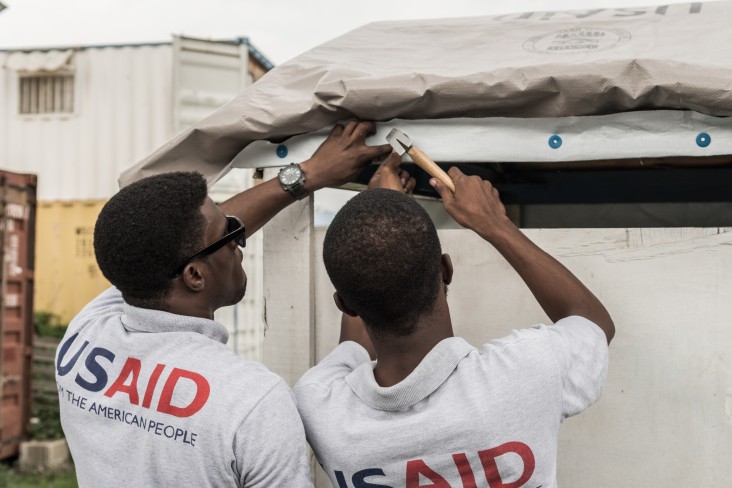Speeches Shim

As shelter remains a critical need after Hurricane Matthew, USAID teamed up with the International Organization for Migration (IOM) to train local staff on USAID’s Disaster Assistance Response Team in Haiti on how to install and use USAID plastic sheeting and shelter kits properly.
Marco Rivera, USAID/OFDA
OVERVIEW
$90.3 MILLION IN FUNDING FROM USAID
To date, in response to Hurricane Matthew, the U.S. Government has committed $101.3 million in funding, including $42.6 million from USAID’s Office of Food for Peace (FFP), approximately $39 million from USAID’s Office of U.S. Foreign Disaster Assistance (OFDA), $11 million from the U.S. Department of Defense, and $8.7 million from the USAID Mission in Haiti. USAID’s assistance is carried out by more than 20 implementing partners and local organizations based in the hurricane-affected southwestern departments of Grande Anse, Nippes, and Sud.
EMERGENCY RESPONSE ACTIVITIES
Joint Task Force
- The U.S. Department of Defense facilitated movement of emergency relief supplies and humanitarian personnel with 98 humanitarian flights to 13 hard-to-reach communes.
Food Assistance
- The World Food Program (WFP), with USAID funding and logistical support, provided nearly 19,000 metric tons of food, reaching nearly 1 million people during a first-round and over half a million people during a second-round of distributions, and provided nutritious food to approximately 70,000 children under the age of 5 and pregnant and nursing women.
Cash-Based Food Assistance
- With USAID funding, WFP also provided cash transfers each to approximately 96,000 beneficiaries, and a consortium of nongovernmental organizations provided cash transfers to more than 85,000 households.
Shelter Assistance
- Approximately 9,100 rolls of reinforced plastic sheeting were airlifted to help meet the emergency shelter needs of up to approximately a half-million individuals.
- Plastic sheeting, fixing kits, and technical assistance were provided to more than 46,000 households.
Water, Sanitation & Hygiene (WASH)
- 38 metric tons of calcium hypochlorite to chlorinate piped water systems prevented water borne diseases and 280,000 people received 5.7 million water purification tablets for safe drinking water.
- 30 mobile water supply units, providing potable water to 100,000 people.
- 50 water systems including piping, wells, and communal springs are undergoing rehabilitation.
Healthcare and Cholera
- 19 mobile health clinics, 12 oral rehydration points, and five cholera treatment facilities
- 85,600 people received medical attention for diseases and injuries at mobile clinics, primary health facilities, and community-based rehabilitation sites.
Road Rehabilitation and Debris Removal
- 875,000 square feet of debris was cleared, 23 miles of roadway cleared, and 18 miles of new road access created, temporarily employing more than 6,000 people daily.
Emergency Operations Center Strengthening
- Supported the Civil Protection Directorate (DPC) – the Government of Haiti agency responsible for emergency preparedness and response – with 22 local surge consultants for evacuation, preparation, and response at the department emergency operation centers.
- Supported the DPC with five short-term staffing positions specialized in disaster logistics, communications, protection, and GIS mapping.
ONGOING RECOVERY ACTIVITIES
Agricultural Recovery and Food Security
- Vouchers distributed to nearly 17,000 households to access to quality seeds and agricultural inputs.
- Providing about 32,000 households with cash transfers during the lean season (April to June).
- 200 sorghum farmers received cash advances.
- Farmers in 12,000 households received high-yield black bean and pigeon pea seeds.
- Training farmers and entrepreneurs selling 1,000 tons of improved maize seed.
Build Back Safer Shelter Initiatives
- Build Back Safer programs are providing training and durable shelter materials to make repairs to withstand future storms and will reach 6,000 households by completion.
School Rehabilitation
- Refurbishing and repairing 50 schools and distributing furniture, supplies, and educational materials to 45,000 children and 1,000 teachers.
Healthcare
- Support to 14 health facilities to expand community health services, including increased WASH activities, the number of mobile clinics, and screenings for malnutrition.
- Providing nutritional supplements and household water treatment to support over 12,000 individuals on HIV treatment as well as orphans and vulnerable children.
Capacity Building for Emergency Operations Center
- Support to DPC to help improve departmental emergency operations centers through technical and material assistance, including multi-agency and ministry coordination, advocacy, and planning support.


Comment
Make a general inquiry or suggest an improvement.